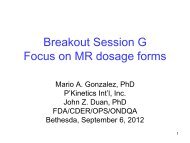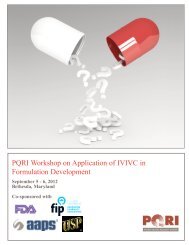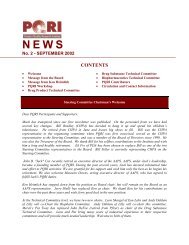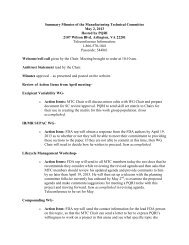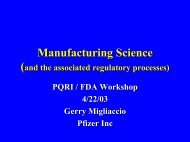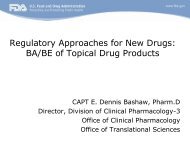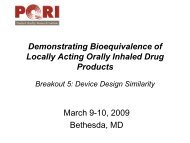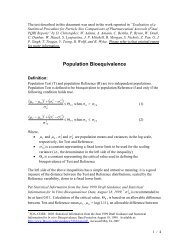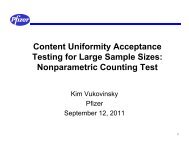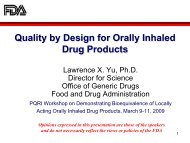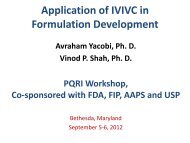Determination of Water Vapor Transmission Rate for High ... - PQRI
Determination of Water Vapor Transmission Rate for High ... - PQRI
Determination of Water Vapor Transmission Rate for High ... - PQRI
You also want an ePaper? Increase the reach of your titles
YUMPU automatically turns print PDFs into web optimized ePapers that Google loves.
Table 6<br />
Comparison <strong>of</strong> Type, Condition, and Slope Method Using RSD<br />
Type Condition Slope Method<br />
Mean<br />
Slope<br />
(mg/day)<br />
RSD(%)<br />
Between<br />
Sites&Runs<br />
RSD(%)<br />
Between<br />
Containers<br />
RSD(%)<br />
Total<br />
Broached 23C/75%RH Initial - Day 14 2.44 16.44 23.92 29.02<br />
Regression 1<br />
(all) 2.43 14.31 19.99 24.58<br />
Regression 2<br />
(wo Initial) 2.42 14.06 19.40 23.96<br />
Regression 3 2.42 13.50 19.93 24.07<br />
40C/75%RH Initial - Day 14 7.12 17.56 17.43 24.74<br />
Regression 1<br />
(all) 8.02 12.59 14.92 19.52<br />
Regression 2<br />
(wo Initial) 8.18 11.96 14.52 18.82<br />
Regression 3 8.14 10.89 14.99 18.53<br />
Intact 23C/75%RH Initial - Day 14 0.36 44.36 5.97 44.76<br />
Regression 1<br />
(all) 0.28 2.35 2.18 3.20<br />
Regression 2<br />
(wo Initial) 0.27 4.15 2.34 4.77<br />
40C/75%RH Initial - Day 14 1.28 15.59 3.47 15.97<br />
Regression 1<br />
(all) 1.21 2.63 3.02 4.00<br />
Regression 2<br />
(wo Initial) 1.21 2.72 3.39 4.34<br />
Notes: (1) Initial-Day 14 is day point 0 and day point 14. (2) Regression 1 is regression<br />
over days 0 to 42 or 49. (3) Regression 2 is regression over days 7 to 42 or 49. (3)<br />
Regression 3 is regression on days 7, 14, 21, 28, and 35; not much different from using<br />
42 or 49 days.<br />
Conclusions<br />
There was no apparent induction period in the main study; steady state appears to<br />
have occurred by the 7 day time point.<br />
The 9 day study showed irregularity and variable behavior during the first 6 days,<br />
suggesting instability during this period which did not appear in the test as<br />
specified by USP Chapter .<br />
Weight gain was linear over time at steady state; WVTR is constant.<br />
Smaller variability occurred when WVTR was calculated by regression rather<br />
than using the two- point calculation <strong>of</strong> USP .<br />
Mean WVTR rates and container variability were similar between labs within<br />
each <strong>of</strong> the testing conditions.<br />
The higher temperature resulted in higher WVTR rates. RSD’s were similar<br />
between the two temperatures.<br />
Controls (blanks) had statistically significant but small positive slopes. In this<br />
study, the controls had little effect on the WVTR rates <strong>for</strong> the broached bottles.<br />
14



